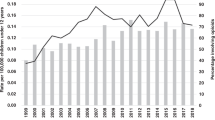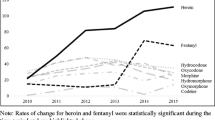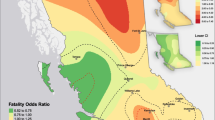Abstract
This article explores trends and correlates of Chicago’s opiate-related overdose (OD) deaths. We manually examined data from every death certificate filed between 1999 and 2003 to identify all Chicago residents’ accidental deaths involving acute intoxication with illicit opiates, OD, or opiate poisoning. The analysis includes an examination of contextual characteristics in 77 Chicago neighborhoods. Negative binomial regression analysis permits the calculation of incidence rate ratios (IRR) associated with time trends. OD incidence peaked in 2000 and then declined markedly by 2003 [year 2000–2003 IRR = 0.65, 95% confidence interval (CI) (0.54, 0.78)]. Over the 2000–2003 period, overall incidence of fatal OD declined by 34%. Over this period, the sharpest observed declines occurred among African-Americans [IRR = 0.64, 95% CI (0.51, 0.81)] and Hispanics/Latinos [IRR = 0.53, 95% CI (0.32, 0.88)]. The opiate-related fatality incidence also declined among non-Hispanic whites [IRR = 0.743, 95% CI (0.52, 1.06)]. Even at the end of the study period, illicit opiate-related OD accounted for 35% of all accidental deaths to Chicago adults aged 18–64, with 45% of OD deaths occurring among African-American men. In summary, illicit opiate OD in Chicago peaked in 2000 and markedly declined by 2003. Opiate OD continues to pose a major threat of mortality to Chicago adults.




Similar content being viewed by others
Notes
For estimation purposes an “injection drug user” is defined as anyone who has injected any illicit substance (e.g., heroin, cocaine, crystal methamphetamine) at least once in the past year.
“Opiate-related” means that the postmortem toxicology report indicated illicit opiate poisoning/intoxication as a primary cause of death.
For example, the coding of multiple drug combination does not reveal the specific drugs involved.
The Social Science Research Committee at the University of Chicago established “community areas” in the late 1920s. A CA consists of an aggregation of census tracts with a collectively shared history and sociocultural public sphere. CA boundaries have remained stable over the past 75 years to allow for cross-time comparisons. The United States Census Bureau has officially sanctioned these areas and organizes Chicago’s census data by tract and by CA.
Naloxone is the generic version of Narcan®.
References
Darke S, Ross J, Hall W. Overdose among heroin users in Sydney, Australia: I. Prevalence and correlates of non-fatal heroin overdose. Addiction. 1996;91(3):405–411.
Darke S, Ross J, Hall W. Overdose among heroin users in Sydney, Australia: II. Responses to overdose. Addiction. 1996;91(3):413–417.
Darke S, Zador D. Fatal heroin ‘overdose’: a review. Addiction. 1996;91(12):1765–1772.
Chiasson M, Berenson L, Li W, et al. Declining HIV/AIDS mortality in New York City. J Acquir Immune Defic Syndr. 1999;21(1):59–64.
Des Jarlais D, Diaz T, Perlis T, et al. Variability in the incidence of human immunodeficiency virus, hepatitis B virus, and hepatitis C virus infection among young injecting drug users in New York City. Am J Epidemiol. 2003;157(5):467–471.
Barkan S, Leonetti A, Hopkins S, Duchin J. Substantial decrease in numbers and rates of AIDS deaths over the last decade [letter to the editor]. J Acquir Immune Defic Syndr. 1999;22(3):312–314.
Edlin B. Prevention and treatment of hepatitis C in injection drug users. Hepatology. 2002;36(5 (S1)):S210–219.
Lorvick J, Kral A, Seal K, Gee L, Edlin B. Prevalence and duration of hepatitis C among injection drug users in San Francisco, CA. Am J Public Health. 2001;91(1):46–47.
Hagan H, McGough J, Thiede H, Weiss N, Hopkins S, Alexander E. Syringe exchange and risk of infection with hepatitis B and C viruses. Am J Epidemiol. 1999;149(3):203–213.
Thorpe L, Ouellet L, Levy J, Williams I, Monterroso E. Hepatitis C virus infection: prevalence, risk factors, and prevention opportunities among young injection drug users in Chicago, 1997–1999. J Infect Dis. 2000;182(6):1588–1594.
Thomas D, Vlahov D, Solomon L, et al. Correlates of hepatitis C virus infections among injection drug users. Medicine (Baltimore). 1995;74(4):212–220.
Centers for Disease Control and Prevention. Heroin overdose deaths—Multnomah County, Oregon, 1993–1999. MMWR Morb Mortal Wkly Rep. 2000;49(28):633–636.
Centers for Disease Control and Prevention. Unintentional opiate overdose deaths—King County, Washington, 1990–1999. MMWR Morb Mortal Wkly Rep. 2000;49(28):636–640.
Strang J, Darke S, Hall W, Farrell M, Ali R. Heroin overdose: the case for take-home naloxone. Br Med J. 1996;312(7044):1435–1436.
Oppenheimer E, Tobutt C, Taylor C, Andrew T. Death and survival in a cohort of heroin addicts from London clinics: a 22-year follow-up study. Addiction. 1994;89(10):1299–1308.
Barnett P. The cost-effectiveness of methadone maintenance as a health care intervention. Addiction. 1999;94(4):479–488.
Hulse G, English D, Milne E, Holman C. The quantification of mortality resulting from the regular use of illicit opiates. Addiction. 1999;94(2):221–229.
Sporer K. Strategies for preventing heroin overdose. Br Med J. 2003;326(7386):442–444.
ACMD. Reducing Drug-related Deaths. London: Advisory Council on the Misuse of Drugs, Stationery Office; 2000.
Donoghoe M. Opioid Overdose. Trends, Risk Factors and Priorities for Action. Geneva: World Health Organization; 1998.
Sporer K. Acute heroin overdose. Ann Intern Med. 1999;130(7):584–590.
Garfield J, Drucker E. Fatal overdose trends in major U.S. cities: 1990–1997. Addict Res Theory. 2001;9(5):425–436.
Holmberg S. The estimated prevalence and incidence of HIV in 96 large U.S. metropolitan areas. Am J Public Health. 1996;86(5):642–654.
Friedman S, Tempalski B, Cooper H, et al. Estimating numbers of injection drug users in metropolitan areas for structural analysis of community vulnerability and for assessing relative degrees of service provision for injection drug users. J Urban Health. 2004;81(3):377–400.
Scott G. Estimating Injection Drug User Population Parameters in Chicago: A Review and Synthesis of Secondary Data for the National HIV Behavioral Surveillance Effort; October 2004. Atlanta: Centers for Disease Control and Prevention; 2005.
Scott G. Ethnographic Assessment of Injection Drug Use in Chicago: A Foundation for Behavioral Surveillance; January 2005. Atlanta: Centers for Disease Control and Prevention; 2005.
Kane-Willis K, Schmitz-Bechteler S. A Multiple Indicator Analysis of Heroin Use in the Chicago Metropolitan Area: 1995 to 2002. Chicago, IL: Roosevelt University; 2004.
Steentoft A, Teige B, Holmgren P, et al. Fatal poisonings in young drug addicts in the Nordic countries: a comparison between 1984–1985 and 1991. Forensic Sci Int. 1996;78(1):29–37.
EMCDDA. 2000 Annual Report on the State of the Drugs Problem in the European Union. Madrid: European Monitoring Centre for Drugs and Drug Addiction; 2000.
NIDA. NIDA Annual Emergency Room Data 1995: Data from the Drug Abuse Warning Network (DAWN). Washington, DC: Department of Health and Human Services; 1995.
Davidson P, McLean R, Kral A, Gleghorn A, Edlin B, Moss A. Fatal heroin-related overdose in San Francisco, 1997–2000: a case for targeted intervention. J Urban Health. 2003;80(2):261–273.
Goldberger B, Cone E, Grant T, Caplan T, Levine B, Smialek J. Disposition of heroin and its metabolites in heroin related deaths. J Anal Toxicol. 1994;18(1):22–28.
Ruttenberger A, Luke J. Heroin-related deaths: a new epidemiological insights. Science. 1984;226(4670):14–20.
Warner-Smith M, Darke S, Lynskey M, Hall W. Heroin overdose: causes and consequences. Addiction. 2001;96(8):1113–1125.
Heinzmann D, DSadovi C, Maxwell T. Deadly Heroin Mix Tightens Grip on City. Chicago Tribune. June 7, 2006;A:1.
Cameron A, Trivedi P. Regression Analysis of Count Data. Cambridge, UK: Cambridge University Press; 1998.
Pollack H, Dombkowski K, Zimmerman J, et al. Emergency department use among Michigan children with special health care needs: an introductory study. Health Serv Res. 2004;39(3):665–692.
Pollack H, Khoshnood K, Blankenship K, Altice F. The impact of needle exchange-based health services on emergency department use. J Gen Intern Med. 2002;17(5):341–348.
Louria D, Hensle R, Rose J. The major medical complications of heroine addiction. Ann Intern Med. 1967;67(1):1–22.
Degenhardt L, Day C, Gilmour S, Hall W. The “lessons” of the Australian “heroin shortage”. Subst Abuse Treat Prev Policy. 2006;1:11.
Massey DS, Denton NA. American Apartheid: Segregation and the Making of the American Underclass. Cambridge, MA: Harvard University Press; 1993.
Venkatesh SA. American Project: The Rise and Fall of a Modern Ghetto. Cambridge, MA: Harvard University Press; 2000.
Darke S, Sims J, McDonald S, Wickes W. Cognitive impairment among methadone maintenance patients. Addiction. 2000;95(5):687–695.
Drucker E. Harm reduction: a public health strategy. Curr Issues Public Health. 1995;1:64–70.
Strang J, Best D, Man L, Noble A, Gossop M. Peer-initiated overdose resuscitation: fellow drug users could be mobilised to implement resuscitation. Int J Drug Policy. 2000;11(6):437–445.
Collins E, Kleber H, Whittington R, Heitler N. Anesthesia-assisted vs buprenorphine- or clonidine-assisted heroin detoxification and naltrexone induction: a randomized trial. J Am Med Assoc. 2005;294(8):903–913.
Maxwell S, Bigg D, Stanczykiewicz K, Carlberg-Racich S. Prescribing naloxone to actively-injecting heroin users: a program to reduce heroin overdose deaths. J Addict Dis. 2006;25(3):89–96.
MacGillis A. City Seeks Expanded Anti-OD Training. Sun. September 27, 2005.
Bennett G, Higgins D. Accidental overdose among injecting drug users in Dorset, UK. Addiction. 1999;94(8):1179–1190.
Caulkins J, Reuter P. Heroin supply in the long-term and short-term perspectives: comments on Wood et al. 2006. Addiction. 2006;101(5):621–622.
Wood E, Stoltz J, Li K, Montaner J, Kerr T. Changes in Canadian heroin supply coinciding with the Australian heroin shortage. Addiction. 2006;101(5):689–695.
Community Epidemiology Working Group. Proceedings of the Community Epidemiology Work Group, volume II; June 2005. Community Epidemiology Work Group; 2005.
Community Epidemiology Working Group, Proceedings of the Community Epidemiology Working Group, Volume II, January 2006.
CDPH. Special Calculation, Chicago OD Mortality. Chicago: Chicago Department of Public Health; 2005.
Darke S, Hall W, Weatherburn D, Lind B. Fluctuations in heroin purity and the incidence of fatal heroin overdose. Drug Alcohol Depend. 1999;54(2):155–161.
Author information
Authors and Affiliations
Corresponding author
Additional information
Scott is with the Department of Sociology, Egan Urban Center, DePaul University, Chicago, IL, USA; Thomas is with the Chicago Department of Public Health, Chicago, IL, USA; Pollack is with the School of Social Service Administration, University of Chicago, Chicago, IL, USA. Ray is with the Department of Sociology and Anthropology, North Carolina State University, Raleigh, NC, USA.
Rights and permissions
About this article
Cite this article
Scott, G., Thomas, S.D., Pollack, H.A. et al. Observed Patterns of Illicit Opiate Overdose Deaths in Chicago, 1999–2003. J Urban Health 84, 292–306 (2007). https://doi.org/10.1007/s11524-007-9157-7
Published:
Issue Date:
DOI: https://doi.org/10.1007/s11524-007-9157-7




